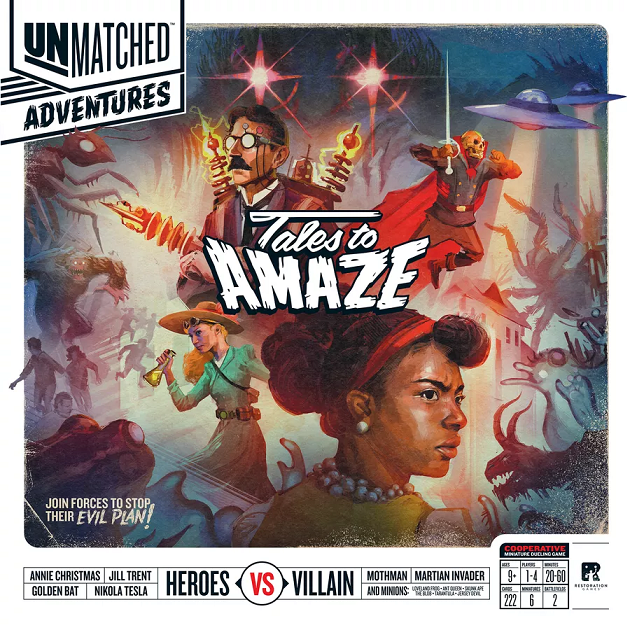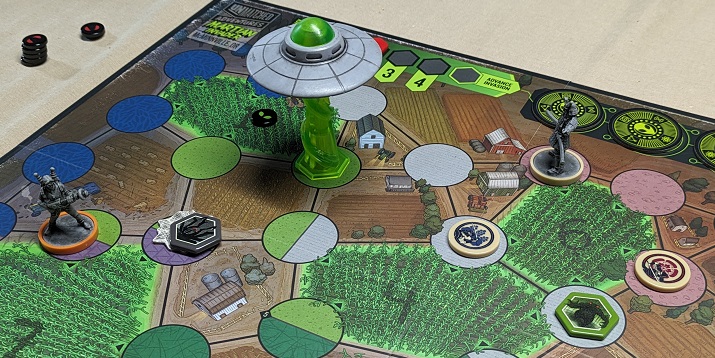Tales to Amaze is a substantive shift in perspective. It’s difficult to overstate just how influential this standalone set will be on the Unmatched product line. This release functionally converts everything Unmatched from a head-to-head skirmish conflict into a replete cooperative boss battler. It boasts more character and stronger ambience than anything thus far released for the game. This is a meaningful extension of an already successful system, and it’s one of the best expansions the hobby has seen.

Restoration Games could have mailed it in. The easiest method to implement cooperative Unmatched would have been to include an AI controlled boss with a behavior deck. Conceptually, a streamlined application of Kingdom Death: Monster or Aeon Trespass: Odyssey, if you will. The core objective of defeating your opponent would have remained, and it would integrate relatively easily into the existing product line. In fact, I lamented the lack of a boss battle structure in my review of the Jurassic Park T-Rex set.
What Unmatched Adventures: Tales to Amaze pulls off, however, is something greater. Instead of a straight up brawl parroting the existing competitive structure, it supports cooperative combat with the scaffolding of scenario play.
This is significant because it provides the impetus for the antagonist to act and manipulate the board. Foes still attack, in fact the AI behavior is simple and direct. When enemies activate, they move towards the closest hero and then drop the elbow. You optionally select a defense card, and then draw the top card of the villain’s deck and resolve the bout just like a normal Unmatched aggression.
Additionally, you don’t simply have to worry about the boss roughing you up. There are a number of minions – based on player count – that function as juiced up sidekicks with their own quirks and identity.
The inflections here make all the difference. Each enemy card has a provocative action, with the standard “during” or “after” combat trigger we’ve seen on fighter cards in the past. This is how the enemy moves unexpectedly or interacts with their scenario objective. For instance, the Mothman may fly to a new area or destroy one of the bridges on its Point Pleasant board. The Alien Invader, similarly, moves to the various fields on its map and beams down aliens to hide in the crops.

The tempo escalates over time, as the villain pushes their specific goals which function as the game’s timer. Each scenario is linked specifically to the villain and map, as these are not interchangeable. What’s so enticing about this system is that it requires only a nudge to the standard Unmatched rules process. All of the enemy action is coded into the combat cards, as well as a clever initiative system.
The initiative deck is slick. It contains cards for each of the participating heroes and foes. They’re all shuffled together and then a card is flipped. This is the character that immediately acts, completing the entirety of their turn before the next initiative card is drawn. This is a wonderful system. It’s the same mechanism utilized in Cosmic Frog and Gorechosen. It establishes a sense of unpredictability that is crucial to play.
The sum of enemy behavior across initiative and combat cards provides for a dynamic battlefield. It’s a haze of activity that clouds the relatively simple AI. There’s an illusion of reaction and aggression, and it’s well-crafted to provide a cooperative experience that is suitably fulfilling.
There is a peculiar quality to this system that’s difficult to characterize. I would posit that a standard competitive match is more gratifying and tense due to the above-table engagement. In Tales to Amaze, there is no element of cracking open your opponent’s skull and gazing into their brain. You can’t divine whether the Jersey Devil is going to play their high value attack or take it easy and refresh their deck (beyond examining probability).
The surrounding context of play, with the infusion of actual setting and variable environmental effects, makes up for the lack of heady card play. Strangely, this shifts how the system is engaged and where part of the pleasure is derived. Without the thrill of outthinking an opponent it instead leans into developing interesting tactical situations. But it also redirects focus to content exploration.
I’ve made this claim in the past, that part of the depth of Unmatched is excised through exploring a variety of fighters and learning new ways to contend with the system. It would be rare to find someone that found this game rich enough to “main” a character as you would in an electronic fighting game. The heroes here just aren’t deep or rewarding enough from this angle. And that’s fine, this is an accessible system that offers a reasonably satisfying brawl in a very short period of time.
So, if you’re like me, you have many fighters. More than enough for how frequently the game hits the table. Unmatched Adventures serves as a conduit for exploring this content. It functions as a noteworthy way to manage and experience – or re-experience – preexisting material. This is a very modern proposal, but it’s a practical one that perhaps says much about how hobbyists like myself interact with this pastime.
Ultimately, it lets me get back to some of my favorite characters that I haven’t seen in a long while. Badasses like Achilles and Medusa. Ones I barely touched such as Big Foot and Muldoon. The game is short and exciting enough to make this pursuit worthwhile in its own right, and all of these old fighters work seamlessly in Tales to Amaze. Surprisingly, some characters even get a needed boost, such as King Arthur gaining some oomph due to the opponent not being able anticipate his boost attack. A card here or there may lose some utility, and it certainly changes the psychology of how some heroes operate, but they are all playable and still maintain their unique style.
It’s fascinating that they were able to accomplish this without swapping out cards in specific decks. The setup in such a situation could have been troubling, but this new way to play is just as welcoming and efficient as the standard mode. That alone is a feat deserving of praise.

The single deficiency of note is the level of challenge. Running it straight, both bosses are simply far too easy. This is most glaring when playing solitaire as the main adversary has a meager 10 health. Many fighters can deliver nearly that amount of damage with a well-executed combo. But even when extending play into the higher participant counts, it falls short of where I like a cooperative game to be.
Currently, I have seen the protagonists win roughly 70% of all matches. This calibration leads to a poor experience beyond a play or two, as there is little tension or impetus for exploring new strategies. The game does offer a tool to deal with this. There is a deck of event cards that you may implement, each card boosting your opponents in some way.
There are some very difficult tweaks, such as requiring the players to defeat all minions in addition to the boss. But there are also some weaker options, including a small bump to movement or negating effects that move enemies around. You can deal these cards out randomly and use as many as you’d like. They’re somewhat volatile and unpredictable in their impact, which can result in swingy plays.
I’m not overly fond of this solution. It can be difficult to remember the additional effects from these cards, particularly when you need two or three of them just to suppress the win rate to a reasonable level. I understand Unmatched is a streamlined game intended to appeal to a wide audience, but I think the standard difficulty receiving a boost would have been better. In that case, this event system could have been used to both increase and decrease difficulty, with players choosing how to massage it based on their skill level. Matt Leacock’s recent cooperative game Daybreak had such a system, and it allows such a wide latitude in manipulation.
While there may only be two bosses included in this box, I find the amount of content quite strong. I’ve gone up against each of the villains several times and at different player counts. The format and scenario design are robust for a 30-minute brawler, offering a relatively wide range of experiences due to the interaction of various fighter abilities with that of the rival, as well as the various minions included. This is not the type of product to blast through with a few plays and then shelve for many months.
The four heroes included are also top shelf. Tesla may be one of my favorite characters in the entirety of the product line, his coils charging over time and then being discharged for massive effect. Annie Christmas is tough as nails and able to dish it out harder as she suffers damage. The Golden Bat is cool as hell, teleporting around and slicing up the competition. Finally, Dr. Jill Trent has a nifty gadget mechanism where you utilize a special piece of gear in addition to your deck of science-focused cards. These warriors are effective in standard Unmatched play and do not at all feel as though they were designed specifically for the Tales to Amaze format.

This is a fantastic expansion due to how it extends the useability of all previous Unmatched content. It does so while offering a solid set of adversaries with their own distinct objectives and storylines for players to thwart. I must still reference the notion that Unmatched has yet to elevate itself to my upper echelon of miniature skirmish titles, but it hovers just a rung below, offering a high degree of satisfaction for the investment it requires.
Unmatched Adventures: Tales to Amaze nudges it skyward, offering an entirely new way to engage the system and find fulfillment. The most thrilling moments may not quite attain the ceiling of competitive play, but the broad experience offered with new considerations courtesy of interesting scenario design is a more than ample tradeoff.
A review copy of the game was provided by the publisher.
If you enjoy what I’m doing and want to support my efforts, please consider dropping off a tip at my Ko-Fi or supporting me on Patreon.

Nice and thorough review! What games are in your upper echelon of miniature skirmish titles?
LikeLiked by 1 person
Thanks! Mythic Battles: Pantheon, Warhammer Underworlds, and Core Space would be my top three. With Marvel Crisis Protocol being just below those.
LikeLike
Speaking of – did you get MB: Ragnarok?
LikeLiked by 1 person
I did not. I don’t know if I can dedicate any more space to the game. I also don’t get to play it as much as I’d like.
LikeLike
The Bosses can be tough if you bring a sub-optimal set of heroes to battle. In our fight against the UFO, my Sinbad the Sailor dished out serious damage, my team-mate the Invisible Man…less so.
My greatest hope is for a second Cobble and Fog victorian gaslamp themed set, or even a return to the game’s roots with a Star Wars set.
LikeLiked by 1 person
I love both of those suggestions. Cobble & Fog is my favorite set, by far.
LikeLike